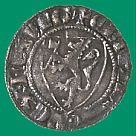KALFARLIEN
Kalfarlien in Bergen
"The site of the find, formerly called Haremsmarken, has been cultivated over the last centuries and earth has been added to the lower part of the rock strewn slope under the mountain. When a large rock was pried loose during road construction work underneath the steep mountainside, the coins rolled out of the cavity behind the rock."
In 1910, some road construction workers in Kalfarlien, just outside
the centre of Bergen, stumbled onto a hoard of approximately 1800 coins
bearing the national coat of arms on the front, and a large cross fleury
on the back. When 1743 of these coins were submitted to the Coin Cabinet,
they were identified as pennies from
the reign of Eirik Magnusson (1280-1299).
Numismatic scholars have since reached the conclusion that the coins must
have been contemporary counterfeits of Eirik Magnusson's famous penny bearing
the national coat of arms.
Above: the "real" penny that was copied for the counterfeits
from Kalfarlien.
This find is remarkable because all the coins in the find are struck with one and the same pair of dies. The counterfeiter had produced one die for each side of the coin and used the pair to mint all of the nearly 1800 pennies found in the scree in Kalfarlien in 1910.
All the coins were in very good shape, almost as if they had never been
circulated. Since all the coins were struck with the same dies, it seems
that the counterfeiter hid the coins instead of putting them into circulation.
What the reason might have been for the coins never having been reclaimed
is open to speculation, but it is clear that the crown considered forgery
a very serious offence. Anyone convicted of such a crime was given a severe
punishment.
"Forgery of our king's coins or his seal is an unforgivable offence." So states the common national law code introduced by Magnus Lagabøte (Magnus the Lawmender) in 1276. A person guilty of such a crime would be made an outlaw without the recourse of paying fines as penance.


